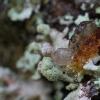
21-12-2025 09:32
Hello.A tiny ascomycete found embedded in wood in

26-12-2025 21:19
Arnold BüschlenPithyella chalaudii Priou. Ist als Bryoparasit in

18-12-2025 21:17
Pol DebaenstThe identification took me to Byssonectria deformi

24-12-2025 17:08
Hulda Caroline HolteHello, I have found this propoloid ascomycete on

21-12-2025 21:32
Pol DebaenstHello, Garden, Burgweg 19, Veurne, BelgiumOn 10/1
I made observations about two jelly fungi last week. This one was on Hypogymnia tubulosa. Area was parklike with small houses. 9.1.2014, Riihimäki, Finland.
- Martti
Yes, Enrique is probably right (and fast !). But microscopy could be useful.
Alain
Actually 45 Tremella species occur on lichens. And probably more are undescribed.
I don't know if H. hypogymniae looks like that. Tremella quickly have differents appearences with different hygrometry.
Here is a photo of H. hypogymniae by Paul Diederich who is the specialist of lichenicolous Tremella.
http://www.lichenology.info/cgi-bin/baseportal.pl?htx=atlas&species~=T&abcspec=T&seeall=
Another species is known on Hypogymnia : H. papuana but I suppose that it isn't a european species.
Alain
Can Exidia grows on lichen? Many has said that this can be maybe Exidia cartilaginea. I made an observation about same style jelly on Malus domesticus on different style lichens...
No, in my knowledge ,there isn't lichenicolous Exidia.
But is it impossible ?
That's the reason why a complete description of your fungus is useful.
Here the latin diagnosis of H. hypogymniae. Unfortunately, I haven't the book of P. Diederich Biblioth. Lichenol. 61: 90 (1996)
Tremella hypogymniae Diederich & M. S. Christ. sp. nov.
Basidiomata lichenicola in thallo Hypogymniae, gallas superficiales, incarnatas, convexas, basim non constrictas, 0.4-1.8 mm in diam. efficientia. Hyphidia nulla. Basidia 2-cellularia, septo longitudinali, obliquo vel transversali, 11-16 x 7-12 pm. Basidiosporae 7-10 x 5.5-7 µm. Cellulae conidiogenae claviformes ad cylindricae, 21-35 x 5-9 µm, immaturae, asteroconidia nulla.
Unfortunately, I haven't the book of P. Diederich : Biblioth. Lichenol. 61: 90 (1996).
Alain
Hi,
I haven't seen fresh Tremella hypogymniae (only one dry herbarium specimen), but I wouldn't expect it to be as thick and translucent as this. Other lichenicolous Tremella species I'm familiar with are very small compared to better known species found in fungus field guides, forming a fairly thin hymenium over galls. Tremella hypogymniae should induce the formation of galls on the host, which are not evident here. Cystobasidium hypogymniicola is another heterobasidiomycete which is pretty common on Hypogymnia in my region (Atlantic Canada), but it definitely doesn't look like this.
Perhaps it is Excidium as you suggest, in which case it is interesting to wonder whether it is closely associated with the Hypogymnia or just growing there opportunistically... Neat.
Best Regards,
Kendra
